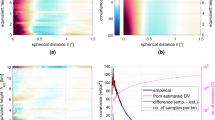Abstract
In this paper a new method to compute in a fast and reliable way the collocation solution is presented. In order to speed up the numerical procedures, some restrictions on input data are needed.
The basic assumption is that data are gridded and homogeneous; this implies that the autocovariance matrix entering in the collocation formula is of Toeplitz type. In particular, if observations are placed on a two dimensional planar grid, the autocovariance matrix is a symmetric block Toeplitz matrix and each block is itself a symmetric Toeplitz matrix (Toeplitz/Toeplitz structure). The analysis can be extended to a regular geographical grid, considered as a generalization of the planar one, taking into account the distortions on the Toeplitz/Toeplitz structure induced by the convergence of the meridians. The devised method is based on a combined application of the Preconditioned Conjugate Gradient Method and of the Fast Fourier Transform. This allows a proper exploitation of the Toeplitz/Toeplitz structure of the autocovariance matrix in computing the collocation solution.
The numerical tests proved that the application of this algorithm leads to a relevant decrease in CPU time if compared with standard methods used to solve a collocation problem (Cholesky, Levinson).
Similar content being viewed by others
References
R. Barzaghi, M. Brovelli, F. Sansó, C. C. Tscherning (1992). Geoid computation in the Mediterranean area. Mare Nostrum, GEOMED Report n° 1, DIIAR, Politecnico di Milano, Milano.
H. Denker (1991). GPS control of the 1989 gravimetric quasi geoid for the Federal Republic of Germany. Determination of the Geoid: Present and Future. IAG Symposia 106, Springer-Verlag, 152–159.
J. Durbin (1960). The fitting of time series models. Rev. Inst. Inst. Stat. 28, 233–243.
K. Eren (1982). Toeplitz matrices and frequency domain collocation. Manuscripta Geodaetica, vol. 7, 85–116.
G. H. Golub, C. F. Van Loan (1983). Matrix computations. North Oxford Academic, London.
H. S. Hou (1987). The Fast Hartley Transform algorithm. IEEE Transaction on COMPUTERS, vol. C-36, n°2.
N. Levinson (1947). The Wiener RMS error criterion in filter design and prediction. J. Math. Phys. 25, 261–278.
H. Moritz (1980). Advanced Physical Geodesy. Herbert Wichmann Verlag, Karlsruhe.
W. F. Trench (1964). An algorithm for the inversion of finite Toeplitz matrices. J. SIAM 12, 515–522.
Author information
Authors and Affiliations
Rights and permissions
About this article
Cite this article
Bottoni, G.P., Barzaghi, R. Fast collocation. Bulletin Géodésique 67, 119–126 (1993). https://doi.org/10.1007/BF01371375
Received:
Accepted:
Issue Date:
DOI: https://doi.org/10.1007/BF01371375




